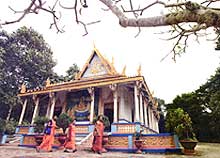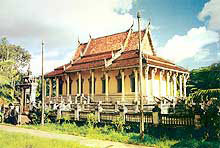Soc Trang, the coastal province in the Mekong Delta, is not only a tourism destination but also a place for worshipping with many well-known pagodas such as Khleang, Doi, Dat Set and Chen Kieu. Most of them are Khmer pagodas, featuring the typical architectural styles of Khmer ethnic people.

The pagoda is essential in the spiritual life of the Khmer people, not only to celebrate religious ceremonies but also to keep Buddhist bibles, artistic and literary works as well as to celebrate cultural ethnic festivals.
Doi Pagoda
Nestled on Le Hong Phong St, Soc Trang Town, Doi (Bat) Pagoda, built in the sixteenth century, is one of the oldest pagodas in the province. It presents an opportunity to contemplate Khmer arts, with skilful, symbolic decorations on its pillars and roof and splendid relieves and statues.
The pagoda is also remarkable for the large number of bats roosting in the trees behind the pagoda. Some have wingspans of more than a meter and resemble large ripe pears as they hang upside down from the upper branches. Visitors can see thousands of bats swinging in immeasurably-high branches, as if performing in a circus. The pagoda is also known as the home of some flitter-mice, or bats, and “five-trotter†pigs.
Currently the pagoda is preserving a stone Buddha statue which is 1.5m high, as well as many bibles written on sugar palm leaves, known as “leaf-booksâ€.
Unfortunately there was a fire at the pagoda in August, 2007 and the sanctum of the pagoda is completely destroyed. Dozens of statues, 60 big candles, curtains and the upper roof of the major temple were razed, but the flocks of bats escaped harm.
Local authorities have decided to spend VND2 billion repairing the pagoda.
Dat Set Pagoda
One kilometer from downtown Soc Trang Town, Dat Set (Clay) Pagoda, also called Buu Son Tu Pagoda, is located at 163 Luong Dinh Cua St, Soc Trang Town. The pagoda is famous for its collection of colorful clay statues, many of which are life-sized. The pagoda includes 13 floors, 208 doors, 208 statues of Buddha and 156 dragons meandering on terraces, all made of clay.
In particular there are six candles, each 200 kg in weight, which have burned constantly for the past 60 years.
This is a family pagoda so there is no monk living here. It is kept by members of the Ngo family who founded the pagoda over 100 years ago. At present, Ngo Kim Tong is the forth generation of the family who presides over the pagoda.
 Khleang Pagoda
Khleang Pagoda
Located at 71 Mau Than St, Soc Trang Town, Khleang Pagoda is an ancient pagoda well-known for the legend of the province. Built in 1533, the pagoda was originally made of wood with a roof thatched with palm leaves. The pagoda was later reconstructed with brick, and the roof was covered with tiles.
Khleang Pagoda has lovely patterns and architectural features that demonstrate the cultural style of the Khmer people in the South. Moreover, in grounds around Khleang there is a spacious space in the shade of ancient green trees, creating a peaceful and poetic atmosphere for passers-by.
Set on a two-level terrace, the doors and windows are decorated with Khmer motifs in bright colors. The gate is decorated in colorful and skilful patterns with three smaller towers above. All parts of the pagoda are covered with grandiose and meticulous work, presenting talent, patience and a harmony of colors of ancient Khmer artisans, as well as goddesses and Buddhists of the Khmer people.
Chen Kieu Pagoda
About 10km from downtown Soc Trang Town, Chen Kieu (Bowl) Pagoda, is located on Highway 1A at Dai Tam Commune, My Xuyen Dist. The pagoda is skillfully decorated with a layer of stylishly designed bowls and plates of different colors by ancient artisans and was built with a spiritual significance.
The first impression is of the motley colors of the pagoda. The sanctum has 16 pillars carved with images of the legends of Khmer culture; the edges of each roof are decorated with patterns and traditional statues of Khmer culture to inspire peace of mind and salvation.
The pagoda also features a spacious precinct and a number of ancient trees contributing to its tranquility and beauty. According to the master priest, Khleang Pagoda was built in 1815 with nipa leaves but was heavily damaged in the war. In 1969 it was rebuilt and the craftsmen used the broken bowls and plates to decorate the pagoda as seen today.